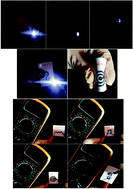Synthesis and electroanalytical behaviour of AgNPs/graphite conductive nano-ink towards biosensing of bacteria genome in human biofluids†
Abstract
Identification of pathogens and diagnosis of infections are imperative health challenges, mainly in the case of fastidious bacteria that are hard to grow. DNA-based biosensors, including gene chips, are of major interest due to their tremendous promise for detecting diseases and obtaining sequence-specific information in a faster, simpler and cost-effective manner compared to the traditional hybridization techniques. In this study, an innovative conductive nano-ink based on graphite/silver nanoparticles (AgNPs) was synthesized and applied towards electroanalytical biosensing of bacteria genome. The prepared nano-ink was drop-casted on the glassy-surface carbon electrode and used for the bioassay of L. pneumophila in real samples obtained from humans. Furthermore, toluidine blue was used as a redox indicator for monitoring the nucleic acid hybridization. So, a conductive ink-based biosensor for the electroanalytical biosensing of L. pneumophila mip gene was constructed by a simple and cost-benefit method. Chronoamperometry technique was applied for the electroanalytical investigation at optimum conditions. The obtained results showed that the proposed nano-ink had excellent conductivity towards electrode modification and sensor construction. Therefore, the proposed interface was applied to DNA hybridization in which toluidine blue was used as a redox hybridization indicator. In addition, the fabricated biosensor showed excellent sensitivity and good selectivity to the one-base and three-base mismatched ssDNA. The acquired results verified that in the ideal conditions, the linear range was 1 μM to 1 ZM and the low limit of quantification was 1 ZM. Finally, graphite–carbon based geno-ink was produced and used for the sensing of target DNA. Consequently, it is apparent that carbon–silver nanoparticles as a novel conductive nano-ink is an ideal material for electrode modification.



 Please wait while we load your content...
Please wait while we load your content...